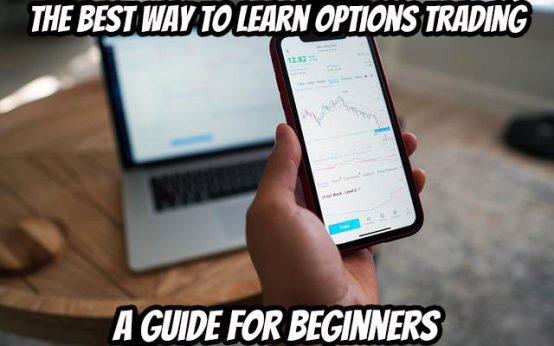So you’re interested in swing trading options, are you?
Well, my friend, if that’s the case then you’ve come to the right place.
This is what we specialize in here.
And when it comes to our members, my team and I inside of “The Empirical Collective” we focus exclusively on swing trading.
Now, that isn’t to say that we don’t think day trading is a bad idea, in fact, my mentor Samuel Goldman (who collaborates and gives us great insight into the trade alerts we give our members) literally wrote the book on day trading. (Which you can see here.)
But for our purposes – and for the vast majority of our members – we feel that swing trading is a better fit.
It allows people to be able to live their life and still trade according to their schedule, without having to be on their computer all day long throughout the trading day.
In addition to that – specifically when it comes to swing trading options – by taking this approach, it allows people to trade smaller account sizes as they can pick and choose the trades from our weekly alerts that they want to trade.
So they don’t feel pressured to over-trade as they might if they were day trading.
Swing Trading Options – The Basics
In case you weren’t already aware, the primary distinction between day trading and 🎉swing trading is the time frame.
Day trading requires all trades to be closed out prior to the close of business on a given day – no positions are ever left open overnight.🌜
Swing trading involves holding trades for days or even months at a time.
Though you don’t need to close out your trades before the end of the day, that doesn’t mean you should become lax in regards to trading.
You must define a trade exit date or exit based on various trading parameters – whether you hit your profit target, close out with a small loss if the trade moves against you or take action because an external news event didn’t transpire as anticipated.
Even though the time🕒frame for day trading is less strict than with swing trading, you still need to employ sound money and account management strategies.
On average, we close out most of our trades within two weeks or sooner, giving us an impressive average return per trade.
Remember – particularly if you’re purchasing options – that the trade must be in the💸 money before its option expiration date or else all of your money will be lost.
So if you’re just starting out, you may want to trade options that are dated a little further out.
Conversly, if you plan to sell options and earn money when placing trades, read this article first.
If all this sounds overwheling, I highly recommend picking up Samuel Goldman’s book “How to Make Big Money Fast Trading Options,” as it provides a great👌 primer for understanding options trading. You can purchase it on Amazon here if you want to read it. 📚
Here is a list of the steps you should take when you’re looking to swing trade options:
- Choose a stock. This is one of the most important things that you can do. You need to check the overall trend of the sector (the direction the industry is headed) as well as the stock itself. Look for any potential catalysts that may influence it such as earnings reports, any big news or things happening in their particular industry.
- Choose your trade. Once you’ve chosen your stock, you need to decide whether you’re bullish or bearish. If you think the stock will go up, you should buy calls. If you think the stock will drop, you should buy puts.
- Choose your strike. Choosing the correct strike is a fine balance between cost and just how much you feel the stock will move. Typically you’ll choose an out of the money strike where you feel the stock expire above. This is the case when trading calls. If you’re trading puts, you’d choose a point the stock would remain below.
- Choose your expiration date. Typically if you’re swing trading you want to choose an expiration of at least one month away. You can go further, but most traders choose about a month as an easy to select time frame
- Choose your entry. You don’t want to try and chase the trend. So if a stock is in an upward trend, wait for a pullback before you buy it. It’s similar for the opposite trade. If it’s in a downward trend wait for the stock to increase in value before buying your puts. By doing this, it gives you a simple way of entering a trade
So there are five basic things for you to follow that will help you get started.
There is more to consider and keep in mind, but this provides a good starting point for swing trading options.
No matter what you decide, if you plan on trading options independently, don’t take any short-cuts. 🚫
To succeed in trading, it’s essential that you invest the time in learning and practicing. (My favorite broker offers a practice account if you don’t already have one.)📖
Your education in stock trading will primarily consist of reading up on the subject and researching methods. But you won’t know everything there is to know without experiencing it first hand, so watch and learn from those in the markets as well.
The only shortcut for successful options swing trading is outsourcing it. You can do this by subscribing to trade alerts provided in a membership.🔔
By trading alongside someone with more experience, you can benefit from their knowledge. This is an excellent opportunity to capitalize on their expertise.🤝
By doing this, you’re able to “earn while you learn.” In some cases, this means that you could begin trading within min utes!⏱️
If you’re search ing for the top options trading newsletter or best options trading alert service, feel free to click one of the previous hyperlinks and read reviews we’ve written – we’ve narrowed it down from an extensive list of services currently available!💻
 How to Paper Trade Options – Plus The 5 Best Free and Paid Trading Platforms
How to Paper Trade Options – Plus The 5 Best Free and Paid Trading Platforms  The Options Trading Mentor: Here’s How to Find the Best One for You
The Options Trading Mentor: Here’s How to Find the Best One for You  The Best Option Trading Success Stories from Average Traders Who Made Millions
The Best Option Trading Success Stories from Average Traders Who Made Millions  The Best Way to Learn Options Trading: A Guide for Beginners
The Best Way to Learn Options Trading: A Guide for Beginners  Here’s The Top WallStreetBets Sentiment Tool on The Market
Here’s The Top WallStreetBets Sentiment Tool on The Market  The Biggest and Most Painful WallStreetBets Losses in Trading History
The Biggest and Most Painful WallStreetBets Losses in Trading History